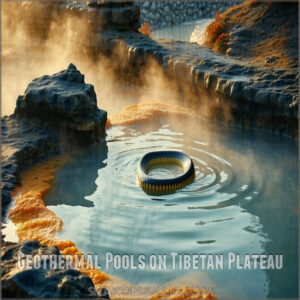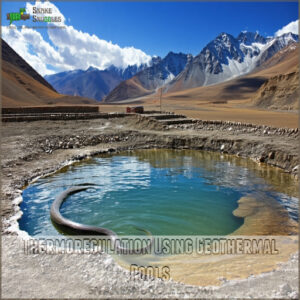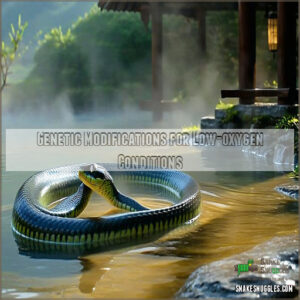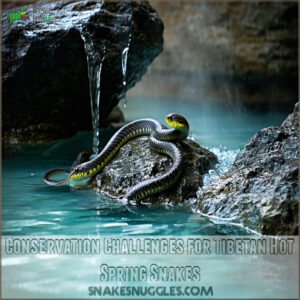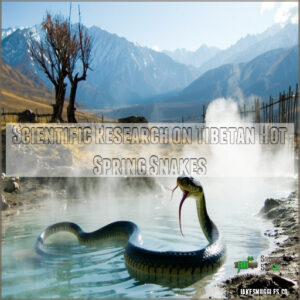This site is supported by our readers. We may earn a commission, at no cost to you, if you purchase through links.
 You’ll be amazed by the Tibetan hot spring snake, a reptilian superhero thriving in scalding geothermal pools at mind-blowing heights of 4,300-4,500 meters.
You’ll be amazed by the Tibetan hot spring snake, a reptilian superhero thriving in scalding geothermal pools at mind-blowing heights of 4,300-4,500 meters.
These genetic marvels have cracked nature’s survival code, sporting UV shields and oxygen-mastering skills that laugh in the face of conditions that’d make other creatures tap out.
With thermal wizardry that lets them dance through freezing mountain temperatures, these snakes are the ultimate high-altitude heat seekers.
Their endangered status adds an edge of mystery – they’re not just surviving, they’re battling against habitat loss and climate change with genetic superpowers that’ll make your jaw drop.
Table Of Contents
- Key Takeaways
- Habitat of Tibetan Hot Spring Snakes
- Unique Adaptations of Tibetan Hot Spring Snakes
- Evolutionary History of Tibetan Hot Spring Snakes
- Conservation Challenges for Tibetan Hot Spring Snakes
- Scientific Research on Tibetan Hot Spring Snakes
- Frequently Asked Questions (FAQs)
- Are Tibetan hot-spring snakes poisonous?
- What are the secrets of Tibet’s hot-spring snakes revealed?
- Are there venomous snakes in Tibet?
- Where do hot-spring snakes live?
- What are the secrets of Tibet’s hot spring snakes revealed?
- Are hot spring snakes venomous?
- Where do hot spring snakes live?
- What is the highest elevation snake in the world?
- How dangerous are Tibetan hot-spring snakes?
- What do Tibetan hot-spring snakes eat?
- Conclusion
Key Takeaways
- You’ll discover Thermophis baileyi is a remarkable snake that survives in extreme high-altitude environments at 4,300-4,500 meters, thriving in geothermal pools where most creatures would perish.
- You’ll be amazed by its incredible genetic adaptations, including unique heat-sensing abilities, UV radiation resistance, and specialized proteins that allow it to withstand thermal stress and low-oxygen conditions.
- You’ll learn that this endangered species faces critical conservation challenges, with habitat destruction, climate change, and human activities threatening its delicate ecosystem in the Tibetan Plateau.
- You’ll understand that the snake’s survival offers scientists crucial insights into evolutionary adaptation, demonstrating nature’s extraordinary capacity to develop survival strategies in the world’s most extreme environments.
Habitat of Tibetan Hot Spring Snakes
You’ll find the Tibetan hot spring snake thriving in the most extreme environments on Earth, nestled in scalding geothermal pools high up on the Tibetan Plateau.
These remarkable reptiles have adapted to survive at altitudes between 4,300 and 4,500 meters, where few other creatures can exist, making them nature’s ultimate high-altitude heat-seekers.
Geothermal Pools on Tibetan Plateau
Imagine nature’s hidden jacuzzis nestled in Tibet’s rugged terrain—geothermal pools that are more than just steamy water features.
These underground heat-powered oases are lifelines for the incredible Thermophis baileyi, transforming harsh Himalayan landscapes into thriving ecosystems.
These pools, rich in unique hot spring chemistry, provide critical habitat in the extreme alpine biodiversity of the Tibetan Plateau.
They are essential for maintaining the delicate balance of the ecosystem, and their geothermal pools support a wide range of plant and animal life.
Elevation Range of 4000-4500 Meters
Ever wondered what it takes to survive where most can’t breathe?
The Thermophis baileyi snake conquers the high-altitude environment between 4000-4500 meters, laughing in the face of extreme conditions.
- Razor-thin oxygen levels that’d make mountain climbers wheeze
- Ultraviolet radiation intense enough to strip paint
- Temperature swings that’d challenge even the toughest survival gear
These mountain ecology masters own their treacherous Himalayan terrain like true champions.
Specific Locations in Tibet Autonomous Region
Ready to track these heat-loving serpents?
The Tibetan Mountains hide Bailey’s snakes in sacred hot springs across remote valleys.
From Gyirong County’s rocky terrain to Lhasa’s nunnery slopes, these high-altitude hunters roam the tibetan plateau’s geothermal wonderlands.
This endangered reptile faces threats from geothermal energy exploitation.
Each hot spring tells a story of survival in the world’s most extreme ecosystem.
Adaptation to Extreme High-altitude Environments
Zooming past typical survival limits, Tibetan hot spring snakes rock some mind-blowing high-altitude superpowers:
- Oxygen mastery in air so thin it’d make humans gasp
- Thermal wizardry for coping with freezing mountain temperatures
- UV shield protecting their delicate skin from intense mountain sunlight
These Thermophis baileyi aren’t just surviving – they’re conquering the mountain’s toughest challenges with genetic genius.
Unique Adaptations of Tibetan Hot Spring Snakes
Ever wondered how a snake survives in scorching hot springs at mind-blowing altitudes where most creatures would cook.
You’ll be amazed by the Tibetan hot spring snake’s incredible genetic superpowers that let it thrive in extreme conditions, from mutated heat-sensing genes to specialized proteins that help it resist thermal stress, including its ability to withstand thermal stress.
Thermoregulation Using Geothermal Pools
When you’re surviving at 4,900 meters, geothermal pools aren’t just a luxury—they’re a lifeline.
The Tibetan hot spring snake (Thermophis baileyi) masters thermal springs like a heat-seeking pro, turning these volcanic hot tubs into nature’s most epic survival strategy.
For further insight, explore resources on geothermal snake adaptation.
Sadly, this unique species faces serious threats, as detailed in a 2019 scientific study.
By basking in warm waters, they dodge freezing temperatures and hunt prey in their toasty thermal oasis.
Genetic Modifications for Low-oxygen Conditions
Because thin air is no match for the Thermophis baileyi, these genetic wizards have cracked the code of high-altitude survival.
Their molecular magic includes:
- Oxygen Sensors that supercharge hemoglobin efficiency
- Genetic Mutations boosting red blood cell performance
- Adaptive Traits enhancing heart muscle resilience
- Genome Sequencing revealing low-oxygen adaptation strategies
Their ability to thrive in such conditions is a testament to their unique biological adaptations, which have been made possible by the aforementioned molecular mechanisms.
UV Radiation Resistance Mechanisms
These Tibetan hot spring snakes have mastered UV survival under intense sunlight.
Their DNA repair mechanisms act like molecular superheroes, fixing UV damage before it wreaks havoc.
With genetic adaptations that act as cellular shields, they’ve built natural sunscreen in their scales.
This high-altitude environment demands incredible radiation tolerance, and these snakes deliver with remarkable precision and persistence.
Nature’s got nothing on them, showcasing the snakes’ impressive ability to thrive with molecular superheroes.
Heat Sensing Abilities Through TRPA1 Gene Mutation
The Tibetan hot spring snake, Thermophis baileyi, has a heat-sensing mechanism straight out of a sci-fi movie thanks to a TRPA1 gene mutation.
This molecular adaptation fine-tunes its thermal regulation in extreme high-altitude environments, enabling it to:
- Detect tiny temperature shifts.
- Target perfect warm spots.
- Dodge dangerously hot areas.
- Thrive near hot springs with unmatched precision.
Heat Shock Proteins for Thermal Stress Management
If you’re wondering how a snake survives near steaming thermal waters, the Tibetan hot spring snake has a secret weapon: heat shock proteins.
These specialized proteins kick in when temperatures climb, protecting cells from damage.
It’s like molecular adaptation on overdrive, boosting thermal tolerance.
Conversely, alpine snake species cold adaptation involves a different set of survival strategies.
The unique protein structure helps Thermophis baileyi thrive in extreme conditions, proving nature’s cellular response is unmatched in high-altitude environments.
Evolutionary History of Tibetan Hot Spring Snakes
You’d be amazed to know how the Tibetan hot spring snake’s unique history was shaped by ancient ice ages, splitting its populations in surprising ways.
Over time, these snakes adapted to their rugged habitat and even tweaked their genes to handle the weird chemistry of local hot springs.
Impact of Past Ice Ages on Population Distribution
Imagine this: during the ice ages, glacial effects carved the Tibetan Plateau into a rugged, frozen maze.
Snakes, stranded in cozy hot spring pockets, faced harsh Ice Age dynamics that triggered species divergence and genetic drift.
These isolated refuges shaped population distribution:
- Small groups clung to geothermal warmth
- Climate migration was impossible
- Genetic drift reshaped isolated groups
- Population shifts molded evolutionary history
Genetic Divergence of Distinct Populations
Not every Bailey’s snake is built the same.
Blame their genetics! Thermophis baileyi populations show fascinating genetic variation due to high-altitude barriers and unique geyser landscapes.
Think of it as nature’s multiplayer survival game!
Here’s a quick breakdown:
| Population | Gene Flow | Local Traits | Region | Barrier Type |
|---|---|---|---|---|
| North Plateau | Low | Hardy lungs | Geothermal zones | Thermal |
| Central Basin | Moderate | Heat sensors | Tibetan midlands | Terrain |
| Southern Region | High | UV resistance | Himalayan valleys | Mountains |
It’s high-stakes molecular evolution out there!
Adaptations to Local Hot Spring Chemistry
These snakes are chemical geniuses!
Living in hot springs with odd water quality, the Tibetan hot spring snake (Thermophis baileyi) thrives thanks to geochemical tolerance and elemental adaptation.
They’ve mastered sulfur metabolism, tweaking their bodies to process unique minerals like selenium and sulfur.
It’s like nature’s lab experiment—turning the harshest, mineral-rich conditions into their cozy high-altitude home.
Comparison With Other High-altitude Species
Stacking Thermophis baileyi against other high-altitude pros reveals wild adaptations!
- Yaks rely on thick wool to battle the Himalayan chill.
- Pikas store food like pros, surviving harsh winters.
- Ground tits puff up feathers to lock in heat.
- Bailey’s snake? It hugs hot springs, blending thermal genius with unique gene tweaks—true masters of mountain ecology and biodiversity!
Conservation Challenges for Tibetan Hot Spring Snakes
You’ve probably never thought about how a snake survives at 14,000 feet, but it’s getting tougher for the Tibetan Hot Spring Snake.
Habitat loss, climate change, and human activity are shrinking their fragile ecosystem, putting this unique species in serious danger.
Habitat Destruction Due to Human Activities
Human impact on the Tibetan Plateau is hitting Bailey’s snake hard.
Habitat destruction from road-building, geothermal energy projects, and resource exploitation is carving up their fragile ecosystem.
Wetlands, essential for nurseries, are vanishing fast, and this land fragmentation triggers ecosystem disruption, leaving the species vulnerable.
Without swift environmental protection, we risk driving this rare snake closer to extinction.
Population Decline and Endangered Status
The Tibetan hot spring snake’s future hangs by a thread.
Listed as Endangered on the IUCN Red List, its population decline is alarming due to habitat loss and isolation.
Key population threats include:
- Small populations vulnerable to disease or environmental shifts.
- Restricted mating opportunities in harsh, short reproduction seasons.
- Threat assessment neglect, with few conservation efforts focused on saving this rare snake.
Climate Change Impacts on Geothermal Habitats
A warming planet is turning the Tibetan hot spring snake’s cozy thermal retreats into an unpredictable game.
Climate change means thermal shifts, dwindling hot spring flows, and geochemical changes.
This fragile high-altitude ecosystem risks water scarcity and species migration, taking the snake’s sanctuary along.
| Challenge | Impact | Possible Outcome |
|---|---|---|
| Thermal Shift | Hot springs lose stability | Habitat fragmentation |
| Water Scarcity | Springs drying up | Reduced population density |
| Ecosystem Disruption | Declining prey availability | Snake starvation |
| Geochemical Changes | Altered spring chemistry | Habitat uninhabitable |
| Species Migration | Competition with others | Declining territory use |
Conservation Strategies and Protected Areas
When considering the protection of these slippery locals, conservation planning is getting creative.
Protected zones and wildlife reserves are safeguarding habitats vital for their survival, while species relocation helps them dodge environmental trouble.
Conservation biology isn’t dull—think snake-sized GPS trackers and community patrols keeping an eye out, plus eco-tours are turning visitors into wildlife champions.
The conservation of Tibetan hot spring snakes relies heavily on snake conservation efforts to guarantee their habitats remain protected.
- Protected zones preserve critical habitats.
- Species relocation ensures safety.
- Community patrols monitor habitats.
- Wildlife reserves offer long-term refuge.
- Snake GPS tracking aids research.
Artificial Den Construction and Wetland Restoration
Protecting the Tibetan hot spring snake means getting creative with solutions like artificial habitats and wetland restoration.
Using smart Den Design Principles, conservation teams craft cost-effective shelters that mimic natural Snake Habitats, helping displaced snakes settle in.
Locals pitch in too, putting their hands to work and adding a dose of teamwork to species conservation.
Meanwhile, Restoration Methods breathe life back into Wetland Ecology, reviving these essential nurseries.
It’s practical Conservation Engineering at its best—saving snakes while keeping their wild homes intact.
By adopting a snake friendly environment approach, such as visiting snake friendly environment, communities can make a significant difference in the survival of these unique reptiles, utilizing effective Den Design Principles and Restoration Methods to preserve Wetland Ecology.
Scientific Research on Tibetan Hot Spring Snakes
You’d be amazed at how much scientists have uncovered about this snake by analyzing its genes and habitat.
From decoding its DNA to tracking its hunting patterns, researchers are piecing together what makes it thrive in such extreme conditions.
Genome Sequencing and Genetic Analysis
You’d be amazed what an exhaustive examination into DNA can reveal.
Genome sequencing cracked open the genetic family secrets of the Tibetan hot-spring snake, highlighting how it thrives where most creatures would call quits.
Through clever genetic mutations, the snake conquers low oxygen, shrugs off harsh UV rays, and survives extreme cold like a champ.
Here’s what the molecular biology uncovered:
- Gene expression tweaks fine-tune breathing in oxygen-thin air.
- DNA repair genes fend off UV damage at dizzying altitudes.
- Protein evolution helps regulate body heat through heat shock proteins.
- Advanced sequencing techniques expose the genetic map driving snake evolution in this high-stakes environment.
The study of Tibetan snake genome sequencing has greatly contributed to our understanding of the species’ adaptability.
Mother Nature’s playbook? It’s pure molecular ecology magic!
Biodiversity Surveys and Population Monitoring
How do you keep tabs on a snake that thrives in some of the planet’s most remote spots?
Biodiversity surveys use tools like infrared cameras and line transects for species tracking and habitat mapping, offering a glimpse into the population trends of the elusive Tibetan hot spring snake.
The Palearctic and Indomalayan regions, described in Eurasian snake habitat research, host diverse snake communities.
Its limited range makes it a bellwether for conservation efforts.
Population monitoring isn’t just data gathering—it’s essential for ensuring ecological balance and species preservation.
Protecting their habitat means giving this bizarre reptile a fighting chance.
Ecological Studies of Prey and Feeding Habits
Ever wondered how a snake survives in Tibet’s frosty heights?
The Tibetan hot-spring snake thrives on a unique diet, including:
- Tadpoles, frogs, and small fish from hot springs
- Ambush tactics perfected for slippery prey
Its feeding behavior is razor-sharp, embracing its ecological niche as a piscivore.
But prey availability swings wildly, proving how fragile its food chain really is.
Collaborative Efforts Between Research Institutions
Want to save the Tibetan hot spring snake? It takes teamwork!
Research partnerships connect scientists worldwide, pooling data, brains, and funding strategies.
From data-sharing agreements to global networking, institutions unite to crack the secrets of this quirky reptile.
Cooperation fuels conservation efforts, with breakthroughs like habitat restoration driven by collaborative snake research.
Together, they’re rewriting wildlife conservation’s playbook—one scaly puzzle piece at a time!
Implications for Understanding Extreme Environment Adaptations
You’ve got to admire Thermophis baileyi—this snake’s extreme survival in a high-altitude environment holds secrets for understanding resilience.
Scientists use its genetic evolution to predict adaptive traits in similar species.
Here’s why it matters:
- Helps explain survival in harsh ecosystems.
- Links to shared high-altitude biology.
- Guides biodiversity and ecology efforts.
- Builds strategies for fragile habitat conservation.
Frequently Asked Questions (FAQs)
Are Tibetan hot-spring snakes poisonous?
With only 3 hot spring snake species globally, you’ll be relieved to know Bailey’s snake isn’t poisonous.
It’s a shy, non-venomous predator that’d rather slither away than attack, focusing on small fish and frogs in Tibet’s high-altitude regions, where it preys on small fish and frogs.
What are the secrets of Tibet’s hot-spring snakes revealed?
Explore the domain of Bailey’s snake, a rare Himalayan species thriving near hot springs.
Its genetic superpowers help it survive extreme altitudes, revealing nature’s incredible adaptation strategies in Tibet’s harsh landscape, showcasing incredible adaptation.
Are there venomous snakes in Tibet?
Like tiptoeing through a minefield, you’ll breathe easy knowing Tibet’s snake scene is mostly non-venomous.
Bailey’s snake and local species rarely pack a toxic punch, making your Himalayan adventures safer than you’d expect, with the overall environment being relatively non-venomous.
Where do hot-spring snakes live?
You’ll find these rare snakes nestled in Tibet’s high-altitude regions, specifically near hot springs in rocky river valleys at elevations above 4,300 meters, within the Himalayan Tibetan Plateau’s challenging landscapes.
What are the secrets of Tibet’s hot spring snakes revealed?
Unravel the genetic mysteries of Tibet’s hot spring snakes: unique adaptations let them thrive at extreme altitudes, with specialized temperature sensing and DNA repair mechanisms that defy survival challenges.
Are hot spring snakes venomous?
Slithering safely, hot spring snakes aren’t venomous threats.
You’ll be relieved to know these shy reptiles prefer fish and frogs over human confrontations, peacefully traversing their high-altitude Tibetan habitats without poisonous defenses.
Where do hot spring snakes live?
You’ll discover Bailey’s snakes thriving in high-altitude Himalayan regions near hot springs, rocky slopes, and river valleys.
These unique creatures call the Tibetan Plateau home, specifically between the Transhimalaya and Himalaya mountain ranges.
What is the highest elevation snake in the world?
Wondering how high a snake can climb?
Bailey’s snake reigns supreme at a breathtaking 4,300 meters in the Himalayan Tibetan Plateau, making it the world’s highest-elevation serpent in its chilly, rocky habitat.
How dangerous are Tibetan hot-spring snakes?
They’re mostly harmless, Bailey’s snakes are shy, non-venomous creatures that’ll scurry away from you faster than you can say "hot springs."
They’re more interested in catching small fish and tadpoles than bothering humans.
What do Tibetan hot-spring snakes eat?
When push comes to shove, you’ll find these crafty Tibetan hot-spring snakes chow down on tadpoles, frogs, small fish, and even minnows.
They’re picky predators with a taste for aquatic appetizers near their rocky, hot spring habitats.
Conclusion
Imagine the Tibetan hot spring snake as nature’s ultimate survival artist, painting resilience across harsh mountain landscapes.
You’ve witnessed how these incredible reptiles defy impossible odds, thriving where others would perish.
The Tibetan hot spring snake isn’t just surviving – it’s rewriting the rulebook on adaptation.
As climate challenges mount, these genetic marvels offer scientists essential insights into evolutionary survival strategies.
Their story isn’t just about a snake; it’s a tribute to life’s extraordinary capacity to endure and transform.
- https://www.tibettravel.org/tibet-travel-advice/top-hot-springs-in-tibet.html
- https://en.wikipedia.org/wiki/Thermophis_baileyi
- https://reptiles.fandom.com/wiki/Thermophis_baileyi
- https://snakesarelong.blogspot.com/2013/05/hot-spring-snakes.html
- https://www.sciencedirect.com/science/article/abs/pii/S1055790399907170

